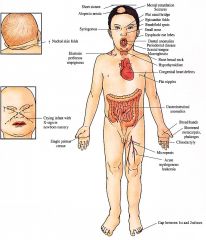![]()
![]()
![]()
Use LEFT and RIGHT arrow keys to navigate between flashcards;
Use UP and DOWN arrow keys to flip the card;
H to show hint;
A reads text to speech;
13 Cards in this Set
- Front
- Back

Clinical Down Syndrome
|

|
|
|
Inheritance
|
Approximately 2% of cases secondary to an inherited translocation; otherwise not inherited
|
|
|
Prenatal
|
Amniocentesis/chorionic villus sampling (CVS): chromosome analysis reveals trisomy 21
Ultrasound: (second/third trimester) constellation of abnormalities may suggest the diagnosis: hydrops fetalis, cystic hygroma, cardiac defects, nuchal edema, prune belly anomaly, duodenal obstruction Increased risk with low levels of alpha fetoprotein in maternal serum not specific or diagnostic for Down's syndrome |
|
|
Incidence
|
Approximately 1:700, 45% of the affected with mothers >35 years old worldwide; 1:1,1100, 20% of the affected with mothers >35 years old in the United States; approximately 11% recurrence risk for parents with affected trisomy 21 child because of nondisjunction; approximately 50% spontaneously abort in second trimester; M=F
|
|
|
Age at Presentation
|
Birth
|
|
|
Pathogenesis
|
Approximately 95% of cases secondary to nondisjunction at chromosome 21 during meiosis in one of the parents (maternally derived in 95%) resulting in trisomy 21; approximately 4% to 5% are secondary to a translocation (inherited and de novo); the remaining 1 % to 2% are mosaics, occuring as a postzygotic event
|
|
|
Clinical
|
Skin .
Single palmar crease, flat nipples, increased nuchal skin folds in infancy, syringo¬mas, elastosis perforans serpiginosa; xerosis and lichenification with age; increased infections Hair Alopecia areata Craniofacial Brachycephaly, flat face, flat nasal bridge with small nose, flat occiput; short, broad neck; small ears with dysplastic/absent earlobes Eyes Epicanthic folds, upslanting palpebral fissures, Brushfield spots, fine lens opacities, strabismus |
|
|
Clinical
|
Mouth
Small mouth with protruding scrotal tongue; fissured, thickened lips; dental anoma¬lies, periodontal disease Musculoskeletal Short stature, hypotonia in infancy; small, broad hands with shortened metacarpals and phalanges; clinoclactyly of fifth finger, wide gap between first and second toes, oclontoid abnormalities, atlantoaxial instability; wide, flat iliac wings with narrow acetabular angle Central Nervous System Mental retardation (IQ 30 50), seizures (10%) Cardiovascular Congenital heart disease (atrioventricular communis and ventricular septa] defects most common) |
|
|
Clinical
|
Gastrointestinal
Duodenal atresia most common; other anomalies Hematologic Acute myelogenous leukemia; transient leukemoid reaction and polycythemia(newborns); immunodeficiency Endocrine Autoimmune hypothyroidism > hyperthyroidism Genitourinary Micropenis, decreased male libido, increased impotency |
|
|
D/Dx
|
None Listed
|
|
|
Lab
|
Chromosomal analysis
X ray pelvis Thyroid function tests Complete blood count Echocardiogram |
|
|
Management
|
Thorough physical examination and follow up with primary care physician
Referral to symptom specific special ist cardiac surgeon/cardiologist, general sur¬geon, hematologist/oncologist, endocrinologist |
|
|
Prognosis
|
While many are now living longer into their fifth and sixth decades of life, average life expectancy is still approximately 35 years; increased mortality in infancy secondary to congenital heart disease, neoplasms
|

